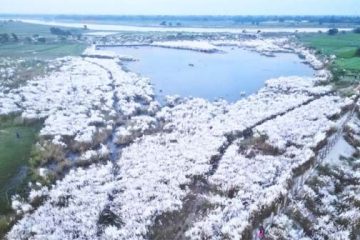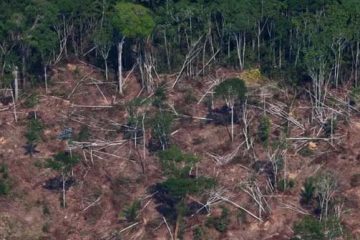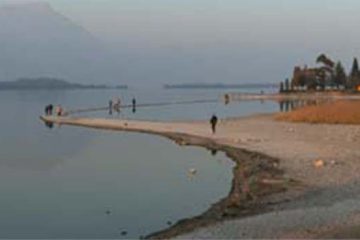DR. M.A. BASHAR
 Adaptation is the habitual process of adjustment to a new or changing environment. These changes of environment could be negative or positive to the survivals in an ecosystem. Adaptive capability is the ability of a system to adjust to climate change to moderate potential damages, to take advantage of opportunities, or to cope with consequences. The value of biodiversity is poorly researched. Biodiversity has an urgent natural has value, but also a direct and indirect human benefit value. It is evident that climate change and biodiversity loss are interconnected. In the fact of inter-linkage, it is found that when climate changes, particular species disappear from their current habitat and new species appear. This is the mystery of species creation and species extinction in nature. Conversely, biodiversity management can be an important measure for helping slow down climate change and its impacts. Local and regional authority (government) can benefit in many ways from integrating biodiversity management into climate protection adaptation strategies.
Adaptation is the habitual process of adjustment to a new or changing environment. These changes of environment could be negative or positive to the survivals in an ecosystem. Adaptive capability is the ability of a system to adjust to climate change to moderate potential damages, to take advantage of opportunities, or to cope with consequences. The value of biodiversity is poorly researched. Biodiversity has an urgent natural has value, but also a direct and indirect human benefit value. It is evident that climate change and biodiversity loss are interconnected. In the fact of inter-linkage, it is found that when climate changes, particular species disappear from their current habitat and new species appear. This is the mystery of species creation and species extinction in nature. Conversely, biodiversity management can be an important measure for helping slow down climate change and its impacts. Local and regional authority (government) can benefit in many ways from integrating biodiversity management into climate protection adaptation strategies.
Over the course of history, ecosystems have always had to adapt to changing, however, is higher than ever recorded. Current rates of climate change have already resulted in species composition changes. Though adaptation is the habitual process of adjustment to a new environment, but possible adaptation options are categorised on the basis of potential responses available to biological organisms. The rapid nature of current climate change means that evolutionary changes as a mechanism for individual species to adapt to a changed climate are very unlikely. Exception could be only in the organisms with short lifecycles. Barring evolution, biological organisms effectively have four possible response options to changes in climate. These organisms are persisters, obligatory dispersers, expanders, and no hoppers. Persisters are those species that have climate tolerance for the new climate. Species belong to the category obligatory dispersers have to move to new areas that maintain their current climate envelopes in the future. The obligatory dispersers can physically move with the changing climate at a sufficient rate to track areas with suitable climates or alternately will have to be moved to new areas with suitable climates if they are unable to move on their own. Expanders are those species that will find new habitat based on the new climates i.e. they can expand into new climatic envelopes that were not previously available. No hoppers are the species that will become extinct if they cannot do one of the above options to be adapted. Potential adaptation options could be identified into five groups on the basis of the responsive options. First adaptation option maintains the current conservation strategy. This adaptation option has the cost associated with current reserve networks and current conservation activities, plus the cost associated with loss of services derived from biodiversity. This adaptation option strategy will also lead to protection of some but not all biodiversity facing a climatic change. Second adaptation option is the recommendation of reserve system. This would entail the strategic purchasing of additional reserve areas to minimise the impacts of climate change on biodiversity. Third adaptation option is matrix management. The matrix management is an area between reserves. Most biodiversity is found within this area, but the proportion of the natural biodiversity remaining is to a large extent dependant on the type of land use activities that are taking place. A number of options are available to manage this area to enhance biodiversity and to ensure that this area is permeable to organism movement so that biodiversity can track a changing climate. Fourth adaptation option is known as translocation. Physically moving biodiversity from one location where the climate has become unsuitable for a species to a new location which is now climatically suitable for the species is an option for situations where species are not able to autonomously move between suitable habitats as the climate changes, either because intervening habitats are inhospitable or because the rate of migration is too slow, or the distance too long. This is a common practice for large animals but is seldom used for plants and insects. Ex-situ conservation is considered as the Fifth adaptation option. This adaptation option is explained in the way that if the future holds no suitable habitats for a species to persist naturally then the only mechanism left to prevent extinction will be ex-situ conservation. This would be in zoos, botanical gardens, seed-bank or cryo-preservation.
These are the ways or options through which the totality of living organisms or biodiversity becomes adaptive to the climatic change. After getting adapted to the changed climate or during adaptation to the changing climate, biodiversity can mitigate climatic changes. Biodiversity management can contribute to climate change adaptation when we can take biodiversity management measures properly. Biodiversity management could be made in different ways, but biodiversity management gets some pre-obstacles before it is to be attempted for practice.
It is stated earlier that, current rates of climate change have already resulted in species composition changes. Biodiversity management is facing constraints from different dimensions. When the climate gets warm up or cools down, many local species have to shift from their current habitat to areas better suited to their needs. This states that with rising of average temperature many species experience a range of shifts towards the poles, potentially pushing out existing species in those areas. In other cases warming causes species to shift their ranges upwards along altitudinal gradients, with the same effect. Changing temperatures influence their reproductive cycles, growth patterns, and also as a result of range shifts, the interaction between species. So, changes to local biological diversity and species composition poses tremendous challenges to conservation planning and implementation. Conservation planning and its implementation is the main vital part of biodiversity management. Biodiversity management needs revision of common conservation practices in order to accommodate the current and future challenges resulting from climate change. Avoidance of rapid and irreversible change in biodiversity is one of the steps for advancement in the biodiversity management. In this case, conservation strategies need to focus more on supporting the species’ natural capacity to adapt to change. Helping species to adapt can avoid the loss of important ecosystem services and the cultural and economic values attached to particular species. It goes without saying that conservation planning at the local and regional level need to create networks of protected areas. This creation increases ‘connectivity’ of the land space and enables species to gradually shift from their current habitats to habitats more suitable for them. If the conservation planning is acted properly in cities and towns as the part of biodiversity management important functions could be carried out. Authorities can make habitat corridors to flora and fauna. If biodiversity exists only in mere ‘islands’ within an otherwise inhospitable landscape, many species will not be able to survive climatic change, as they cannot e to other areas. Further more, local and regional authorities can make some zoning to allow for gradual creation of corridors along linear infrastructures like rivers, roads and railway lines.
Why biodiversity management is necessary to adapt the climate change? It is obvious that, biodiversity plays a crucial but often underestimated role in the mitigation of climate change. Mitigation refers to actions that reduce the extent of global warming. The ecosystem biodiversity is a key factor in ensuring the natural processes undertaken by ecosystems. One of these processes is growth. As they grow, plants, fungus, bacteria all work together to bind carbon dioxide gas from the atmosphere into the soil, wood and other organic matters. This process “sequesters” carbon dioxide from the atmosphere, thereby helping to reduce the amount of green house gas, which is responsible for global warming.
Maintaining local biodiversity and increasing urban green space, in particular forest areas, therefore are significant and effective contributions towards protecting the global climate. In addition to that, local and regional authorities can provide the regulatory framework for encouraging vegetation growth on private properties. As the climate changes, extreme weather events as storms, floods, droughts and heat waves are expected to become more intense and unpredictable. In mitigating the impact of climate-induced disasters an ecosystem can play a crucial role. A biologically diverse and healthy forest ecosystem has a high capacity to absorb torrential rain. Such a forest provides tree cover and undergrowths that can reduce the erosive impact of intense precipitation, slow down the surface run off and support the seepage of rain water into soil lower rock beds. These processes help in reducing the risk of flash floods, mud slides and soil erosion. Conserving a patch of native vegetation may therefore be a key component of integrated disaster risk reduction in the face of climate change.
Biodiversity management therefore needs to become integrated with disaster risk reduction planning and emergency response. Local and regional authorities can help to reduce flood risk by protecting and restoring riverine and coastal vegetation. This helps to regulate a more even flood water in a catchment, reducing the impacts of extreme precipitation, cyclones, hurricanes, storms, tidal surges or coastal wave action. In vegetated areas, the rate of water seepage into the ground is also higher, which reduces the impacts of droughts. These are some of the measures could be derived as the results of the biodiversity management.
All these measures can support local economic and infrastructure systems to adapt to a changing climate. If the biodiversity management carefully planned on the basis of local indicators for climate change, even technologically simple and inexpensive measures can result in tremendous benefits. While national governments in many countries provide national adaptation plans, local and regional authorities have the challenging task to gather local data on climate change and making responsible decisions for local adaptation to climate change. Such comprehensive ‘anticipatory adaptation’ need to focus on technological, socio-economic and ecological support mechanisms alike. Conserving healthy ecosystems and promoting the adaptive capacity of species helps ensure that different environments can retain their ‘fitness’ and continue to provide the ecosystem services so vital for their inhabitants, despite the uncertainties of a changing local climate.
Biodiversity measurement systems need their development strategy to have arranged in combination of training institute, educational institute and various stakeholders. Training systems will have to be addressed by different stakeholders involved in management of resources sensitive to climate variability and changes. They will have to understand the nature of climate change (variability) as well as potential adaptation options. Moreover, knowledge of management and social communication shall have to be continued to support climate risk management functions by stakeholders at government, private sectors and the community at large. Biodiversity management shall have to include assessment deal with climate issues, data collection, analysis, synthesis, assimilation, achieving, transactions, knowledge gap filling, and communication at all levels, dissemination and outreach.
Biodiversity management could have been undertaken in larger sphere and for more specific target and also for specific area. In Bangladesh context, the south-western forest ecosystem biodiversity management could be taken as an ideal example.
[Image (above) in the article is a ‘related image’]
Prof. Dr. M. A. Bashar is Dean, Faculty of Biological Sciences, University of Dhaka.
Via: The Independent Image credit: dan/FreeDigitalPhotos.net





